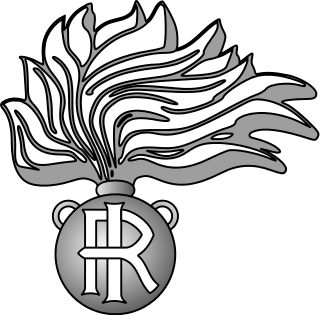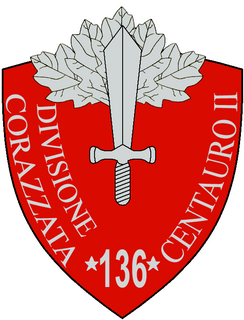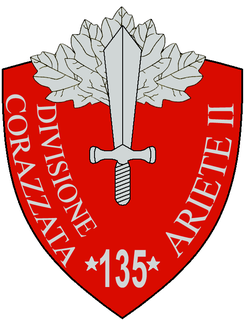Related Research Articles

The Carabinieri are the national gendarmerie of Italy who primarily carry out domestic and foreign policing duties. It is one of Italy's main law enforcement agencies, alongside the Polizia di Stato and the Guardia di Finanza. As with the Guardia di Finanza but in contrast to the Polizia di Stato, the Carabinieri are a military force. As the fourth branch of the Italian Armed Forces, they come under the authority of the Ministry of Defence; for activities related to inland public order and security, they functionally depend on the Ministry of the Interior. In practice, there is a significant overlap between the jurisdiction of the Polizia di Stato and Carabinieri, although both of them are contactable through 112, the European Union's Single Emergency number. Unlike the Polizia di Stato, the Carabinieri have responsibility for policing the military, and a number of members regularly participate in military missions abroad.

The Italian Army is the land-based component of the Italian Armed Forces. The army's history dates back to the Italian unification in the 1850s and 1860s. The army fought in colonial engagements in China, Libya, Northern Italy against the Austro-Hungarian Empire during World War I, Abyssinia before World War II and in World War II in Albania, Balkans, North Africa, the Soviet Union, and Italy itself. During the Cold War, the army prepared itself to defend against a Warsaw Pact invasion from the east. Since the end of the Cold War, the army has seen extensive peacekeeping service and combat in Afghanistan and Iraq. Its best-known combat vehicles are the Dardo infantry fighting vehicle, the Centauro tank destroyer and the Ariete tank and among its aircraft the Mangusta attack helicopter, recently deployed in UN missions. The headquarters of the Army General Staff are located in Rome opposite the Quirinal Palace, where the president of Italy resides. The army is an all-volunteer force of active-duty personnel.

The Italian Civil War was a civil war in the Kingdom of Italy fought during World War II from 8 September 1943 to 2 May 1945, by the Italian Fascists of the Italian Social Republic, a collaborationist puppet state created under the direction of Nazi Germany during its occupation of Italy, against the Italian partisans, materially supported by the Allies, in the context of the Italian campaign. The Italian partisans and the Italian Co-Belligerent Army of the Kingdom of Italy simultaneously fought against the occupying Nazi German armed forces. Armed clashes between the National Republican Army of the Italian Social Republic and the Italian Co-Belligerent Army of the Kingdom of Italy were rare, while there was some internal conflict within the partisan movement. In this context, Germans, sometimes helped by Italian Fascists, committed several atrocities against Italian civilians and troops.

Anti-Aircraft Command was a British Army command of the Second World War that controlled the Territorial Army anti-aircraft artillery and searchlight formations and units defending the United Kingdom.

Operation Achse, originally called Operation Alaric, was the codename for the German operation to forcibly disarm the Italian armed forces after Italy's armistice with the Allies on 3 September 1943.
The 184th Paratroopers Division "Nembo" was an airborne division of the Royal Italian Army during World War II. After the Armistice of Cassibile the division joined the Italian Co-belligerent Army's Italian Liberation Corps and together with the Polish II Corps liberated Ancona in the Battle of Ancona.

The 9th Infantry Division Pasubio was an infantry division of the Royal Italian Army during World War II. The Pasubio was classified as an auto-transportable division, meaning staff and equipment could be transported on cars and trucks, although not simultaneously. The division was formed as an infantry division in 1934, reorganized as auto-transportable division in 1939 and mobilized in August 1940. It was named for the battles on Pasubio during World War I. Its 79th Infantry Regiment and 8th Artillery Regiment were made up of men from Verona, while the ranks of the 80th Regiment were filled with men from Mantua. Its I CC.NN. Battalion "Sabauda" was made up of Blackshirt volunteers from Turin.

The 52nd Infantry Division "Torino" was an infantry division of the Royal Italian Army during World War II. The Torino was named after the city of Turin and classified as an auto-transportable division, meaning staff and equipment could be transported on cars and trucks, although not simultaneously. The division was formed by expanding the Torino Brigade in June 1940 and was based with two of its regiments in Civitavecchia, while the 81st Infantry Regiment "Torino" was based in Rome. The division took part in the Invasion of Yugoslavia and was then sent to the Eastern front as part of the Italian Expeditionary Corps in Russia.
The 208th Coastal Division was an infantry division of the Royal Italian Army during World War II. Royal Italian Army coastal divisions were second line divisions formed with reservists and equipped with second rate materiel. Recruited locally, they were often commanded by officers called out of retirement.

The 7th Infantry Division "Lupi di Toscana" was an infantry division of the Royal Italian Army during World War II. The Division, with the exception of the 78th Infantry Regiment based in Bergamo, was based in Brescia. Despite its name referencing the region of Tuscany, the division was formed by men from Lombardy, especially from Brescia, Bergamo and the surrounding valleys.

The 136th Armored Legionary Division "Centauro" was an armored division of the Royal Italian Army during World War II. The division had been formed in June 1942 as 1st CC.NN. Armored Division "M", but was renamed after the fall of the fascist regime in July 1943. In September 1943 it was in training near Rome and was disbanded by the Germans after the announcement of the Armistice of Cassibile.

The 20th Infantry Division "Friuli" was an infantry division of the Royal Italian Army during World War II. The Friuli was formed on 24 August 1939 by splitting the 20th Infantry Division "Curtatone e Montanara" into the Friuli and the 44th Infantry Division "Cremona". The Friuli was named for the region of Friuli, but based in Tuscany, where it also recruited most of its troops. The division's headquarter and its regiments, with the exception of the 87th Infantry Regiment located in Siena, were based in Livorno. The division served as occupation force on Corsica and fought German units after the Armistice of Cassibile was announced on 8 September 1943. The division then served with the Italian Co-belligerent Army and remained active into the early stages of the Cold War.

The 31st Infantry Division "Calabria" was an infantry division of the Royal Italian Army during World War II. The Calabria was formed in Sassari and named for the region of Calabria. The division was part of the garrison of Sardinia, where it remained until the Armistice of Cassibile, after which it served in the Italian Co-belligerent Army.

The 44th Infantry Division "Cremona" was an infantry division of the Royal Italian Army during World War II. The Cremona was formed on 15 September 1939 by splitting the 20th Infantry Division "Curtatone and Montanara" into the 20th Infantry Division "Friuli" and 44th Infantry Division "Cremona". The division was named for the city of Cremona. The division served as occupation force on Corsica and fought German units after the Armistice of Cassibile was announced on 8 September 1943. The division then served with the Italian Co-belligerent Army and remained active until the 1975 Italian Army reform.
The 226th Coastal Division was an infantry division of the Royal Italian Army during World War II. Royal Italian Army coastal divisions were second line divisions formed with reservists and equipped with second rate materiel. They were often commanded by officers called out of retirement.

Ezio Rosi was an Italian general during World War II. He commanded the Sixth Army from 1941 to 1943, and after a brief period as Army Chief of Staff, he assumed command of Army Group East in 1943.
Umberto di Giorgio was an Italian general during World War II, in charge of the territorial defense of Rome from 1939 till September 1943.
Enrico Adami Rossi was an Italian general during World War II.
Armellini Chiappi was an Italian general during World War II. He was in command of the territorial defense of Florence for most of the war.

The 135th Armored Cavalry Division "Ariete" was an armored division of the Royal Italian Army during World War II. It was formed in 1943 and named to commemorate the 132nd Armored Division "Ariete", which had distinguished itself during the Western Desert campaign and was destroyed during the Second Battle of El Alamein. After the announcement of the Armistice of Cassibile on 8 September 1943 the division fought the invading German forces South of Rome. After two days the division was forced to surrender and was disbanded by the Germans on 12 September 1943.